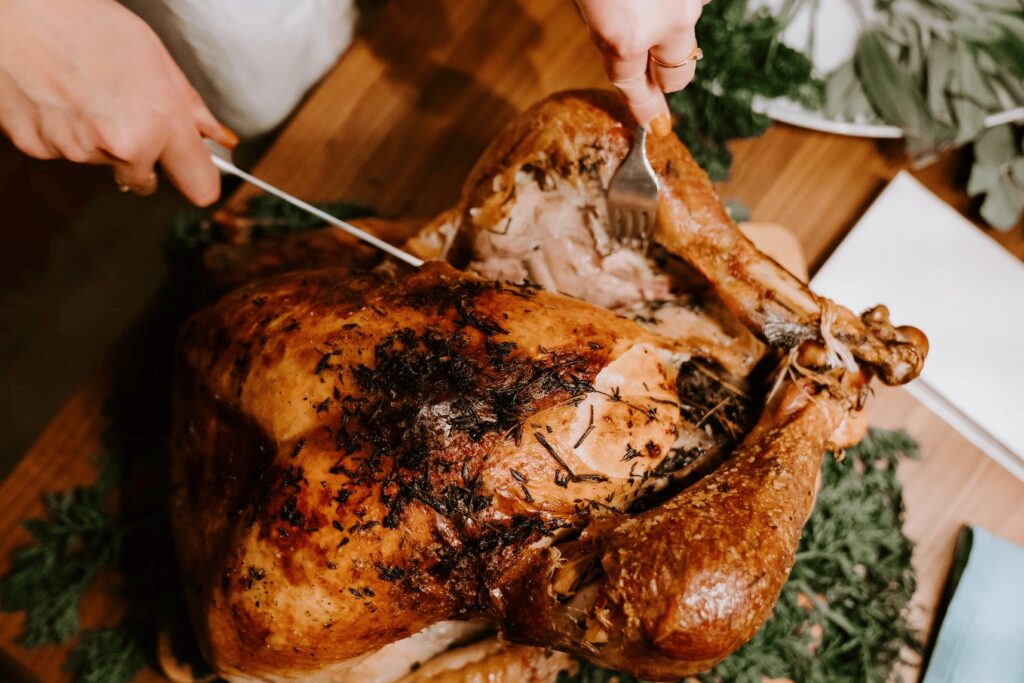
7 Tips For a Perfect Thanksgiving Turkey

7 Tips for a Perfect Thanksgiving Turkey
Whether this is your first or tenth year making the turkey for Thanksgiving dinner, it can be a daunting task. With the big day quickly approaching, let us help boost your confidence with some Thanksgiving turkey tips from the pros!
- Start by picking the right bird. You don’t want to underestimate how much meat you need, but you also don’t want to deal with cooking much more than necessary. A common rule of thumb is a pound of turkey per guest, but we’d recommend slightly more than that just to be safe – 1.25 pounds per guest is the perfect sweet spot! So for a group of 12, a 15 pound turkey should be just right.
- The thawing process matters. The safest way to thaw your frozen turkey for Thanksgiving is to transfer it to the fridge in advance, but you have likely also heard of the cold water bath method. While both are fine to use, be sure you’ve done your research on whichever method you choose and do it correctly. If you have a large turkey, you should be making a thawing plan today – for reference, a 15 pound bird will take about three days in the fridge to thaw. It truly is imperative that you completely and safely thaw your turkey before cooking; it may be tempting to say “good enough!” and throw it in the oven while some parts are still a bit frozen, but it really is dangerous. It won’t matter how delicious a meal was if it gave the guests a food borne illness!
- Try a brine. Listen, we appreciate turkey as the traditional Thanksgiving main dish, but we also know that it’s not the most tender meat out there. The best way to combat the dryness of turkey meat (aside from not overcooking it) is to soak the whole bird in a brine solution, preferably overnight. A basic brine consists of about a gallon of water and 2 cups of kosher salt (this amount should be enough for an 18 to 20 pound turkey) but you can also add other ingredients to add some complexity to the flavor of the meat – one of our chef instructors recommends trying some sprigs of rosemary, black peppercorns, and orange and lemon slices! Bring some of the water to a boil with the salt until it dissolves, then add the rest of the water to cook the solution before pouring over your turkey and placing in the fridge. Soaking in a brine solution will ensure that the meat is tender and moist even at the end of the cooking process, and it definitely worth the extra effort.
- Get under the skin. Yes, you read that right! A fantastic way to make your turkey flavorful this Thanksgiving is to season not only the entire exterior of the bird, but to also rub butter and seasoning up underneath the skin. Get creative with flavoring the butter, don’t be afraid to think outside the salt and pepper and add fresh herbs like thyme or spices like paprika.
- Invest in a good probe thermometer. If you’ve ever waited around for an extra two hours waiting for Thanksgiving dinner to be ready, you know it can be hard to gauge just how long a turkey takes to roast. Even if you researched ahead of time exactly how long your 18 pound turkey should be in the oven, sometimes it takes another hour for seemingly no reason, right? But the most likely reason is that you’ve sabotaged yourself by checking on it. Every time you open the oven to check the temperature of the turkey, heat escapes and the temperature drops, dragging out the cooking process. Using a probe thermometer that can be left in the meat and seen without opening the oven door allows all the heat to be retained and the cooking process to move along normally. We highly recommend this model from Thermoworks. Remember that poultry is safe to eat at 165 degrees Fahrenheit, and that the longer you leave it in beyond that temperature, the drier and more tacky the meat will be. If you feel confident, consider pulling your turkey out a few degrees “early” and letting the beauty of carryover cooking finish bringing the meat to temperature. (Just be sure to temp it again after a couple minutes to ensure it has in fact reached 165.)
- Let it be. Turkey needs to rest after cooking longer than you probably think in order to reabsorb juices and retain moisture. You will find suggestions all over the map regarding how long to let a turkey rest, but our suggestion is at least 30 minutes and up to an hour for a larger bird. Be sure to factor in resting time when planning out your cooking. If you’re concerned about retaining heat during this time, you can tent the turkey with foil while resting, but keep in mind that doing so will cause some condensation and make the skin a bit more soggy. You will be surprised how warm your turkey still is after 30 minutes without being wrapped up, but if it is a little less hot than you’d like, you can always top it with some warm gravy! Keeping the juices inside the meat instead of pouring everywhere when you slice into it will be well worth it.
- Lastly, if you’re looking for a way out of the whole turkey roasting rigmarole, consider an alternative. If a whole bird feels overwhelming, you can always buy something else to serve at Thanksgiving – a couple of individual turkey breasts and oven roast, sous vide and reverse sear, or even smoke them!
Poultry in general can be intimidating to cook, but if you prioritize retaining moisture and cooking to the proper temperature (but no more!) you’ll have a lovely main dish you can be proud to serve guests. Good luck, we believe in you!
Bonus tip: don’t forget to dig around inside the cavity of your turkey before cooking – there’s likely a packet of giblets in there you won’t want to leave in! Save them from the oven and use them to make your gravy if you’re feeling bold.
If you thought this article was helpful and are excited to learn more, sign up for our professional culinary institute or check out our cooking class calendar!


